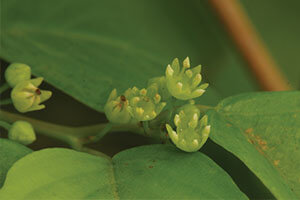The Rhamnaceae consists of about 58 genera (10 native to the US) and 900 species, which consist of trees, shrubs and vines, and only rarely, herbs. The family is found in many parts of the world.
The leaves are simple (not compound) can be placed either alternately or oppositely on their stems and come with a pair of
stipules.1
The flowers are bisexual (have both male and female parts), are relatively small, radially symmetrical,2 and the stamens, petals and sepals are borne on a cup or tube-like structure that surrounds the female part of the flower (perigynous). They can be either greenish or brightly colored. The calyx3 generally breaks into 5 but occasionally 4 parts, the sepals. There are generally 5 separate petals but occasionally there are 4 and sometimes none. There are usually 5 stamens, but occasionally only 4, and are located opposite the petals. The pistil (female part of the flower) consists of, 2 or 3 parts (carpels), which often can be detected by the number of parts into which the head of the pistil (stigma) is divided. The seeds form at the bottom of the ovary (basal placentation). The fruits are capsules4 or drupes.5
The family has little economic importance. It provides a few edible fruits and a few ornamentals.[13]
References:
Smith. J. P. Jr. 1977. Vascular Plant Families. Mad River Press. Eureka, California.
Supplejack, Alabama supplejack, rattan vine

Origin: Native to North America.[12]
Plant description: The stems of the plant are high climbing, tough and flexible. The leaves have leaf stems (petioles) and range in shape through ovate, oval and oblong6 (see Kennon Lorick’s Leaf Basics Glossary in the October 2013 ABJ). The leaves range 3-6 cm (~1.2-2.4 in) in length and can taper to a point with more or less straight sides or be more rounded. The leaf edges are entire (without teeth or other indentations) are glabrous (smooth and hairless) and can have a wavy edge. There are several conspicuous parallel ascending7 veins.
The individual flowers are greenish white[6], arranged in 1-5 cm (~0.4-2.0 in) long panicles.8 The sepals and petals of the individual flowers are 2 mm (~0.08 in). Harvey Lovell[4] describes the flowers as being distributed as clusters of greenish flowers generally in the tops of trees, but at times they are found in much drier upland limestone glades where they become sprawling vines that trail along the ground.
The bluish fruits[6] are oval or oblong, slightly compressed, and 6-8 mm (~0.24-0.31 in).[3] The fruits should not be eaten since they are mildly toxic to humans.[6]
Distribution: The species is found in swamps, wet woods, wet hammocks, floodplains, forests, and wet flatwoods. In the Eastern Seaboard States it is found chiefly on the coastal plain.[3] In the Gulf, its distribution extends farther inland and even follows the Mississippi River to the tip of Illinois. Wunderlin[13] indicates that the plant is found “nearly throughout” Florida. In Texas it is found along ravines and low woodlands.[10] See also the provided distribution map.
Blooming period: Gleason and Cronquist[3], which covers only the northern portion of the plant’s distribution, provides a blooming date of May. Wunderlin[13], writing about the vascular plants of Florida, states simply that it blooms in spring. In Texas, Sanborn and Scholl[10] indicate it blooms in April. John Lovell[5] reports in Southeastern Texas it blooms April to July and sometimes, if there are summer rains, it might bloom again.
Importance as a honey plant: From his extensive set of questionnaires Oertel[8] found the species to be important in: LA, TX, AL, AR, MS, NC, SC, and TN.
Ayers and Harman[2] from their questionnaires found the plant to be very important in: OK, MS, TX, LA and MS and to be important in AR.
While the standard references listed above provide information about the plant as a bee forage, there are a number of publications that enumerate the…


